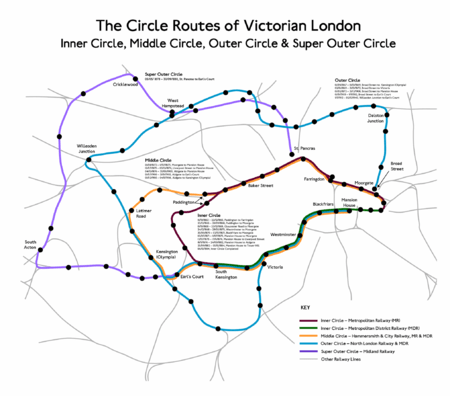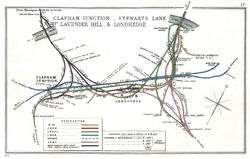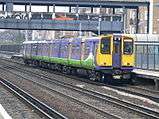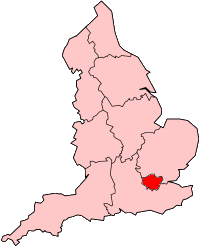West London Line
The West London Line is a short railway in inner West London that links Clapham Junction in the south to Willesden Junction in the north. It has always been an important cross-London link especially for freight services. Regular passenger services on it, detailed below, are provided by Southern and by London Overground.
History
Origins
The Birmingham, Bristol & Thames Junction Railway was authorised in 1836 to run from the London and Birmingham Railway (L&BR), near the present Willesden Junction station, across the proposed route of the Great Western (GWR) on the level, to the Kensington Canal Basin. Construction was delayed by engineering and financial problems. Renamed the West London Railway (WLR) the line officially opened on 27 May 1844, and regular services began on 10 June, but before that trials to demonstrate the potential of the atmospheric railway system had been held from 1840 to 1843 on a half-mile section of track adjacent to Wormwood Scrubs, leased to that system's promoters;[1] The WLR used conventional power but was not a commercial success. The low number of passengers became such a regular target of Punch magazine that the line was called Punch's Railway. After only six months it closed on 30 November 1844.
An Act of 1845 authorised the GWR and the L&BR (which became part of the London and North Western Railway [LNWR] in 1846) to take a joint lease of the WLR. The line was used only to carry coal, and passenger service was not re-introduced.
An Act in 1859 granted those two companies, with the London, Brighton and South Coast Railway (LB&SCR) and the London and South Western Railway (L&SWR), powers to construct the West London Extension Joint Railway on the filled-in canal south from the Kensington Basin to the bridge under the Kings Road, to bridge the Thames and to connect near Clapham Junction to railways south of the river.[2] The existing line was doubled, and the flat crossing of the GWR main line, where a number of collisions had occurred, was replaced by a flyover.[3] The new line opened on 2 March 1863 with a passenger station at Addison Road (now Kensington (Olympia)) slightly north of the original Kensington station, and was then well used by various inner London services for the remainder of the nineteenth century.
Operations to 1940
For a time, the West London Line formed part of the GWR's Middle Circle route (1872-1905) which ran (clockwise) from Mansion House to Aldgate via Earl's Court, Earl's Court, Kensington Olympia, Latimer Road and Baker Street. The West London Line was also part of London Underground for a time and operated as a branch of the Metropolitan Railway between Edgware Road and Addison Road. The branch was eventually closed and the link between the West London Line and today's Hammersmith & City line was dismantled in 1930.
A branch was installed to allow trains from the former Southern Railway to access to the West Coast Main Line and vice versa: in summer the London Midland and Scottish Railway ran from as far north as Glasgow to the South Coast. Through trains in the steam era changed locomotives here. From the 1920s there was a United Dairies depot on the site of a former dairy farm here, which up until the late 1970s had regular milk train deliveries.[4]
The northern section of the line, from Willesden Junction to Kensington Olympia and on to Earls Court, was electrified by the LNWR in 1915.[5]
Decline after World War II
After a period of popularity, passenger usage dwindled on the West London Railway. Competition from the new deep-level Underground railways and electric tramways took away custom by offering more direct routes into Central London. With the onset of World War II, the West London Line was badly hit in some parts by enemy action during the Blitz and the demise of the line was hastened by wartime bombing. In 1940, LMS steam trains from Clapham Junction to Kensington ceased on 20 October and Willesden-Edgware Road electric services ceased on 20 October.[6]
In 1948, the line became part of British Rail, following the nationalisation of the railways, but remained mostly in use as a freight route. For many years, limited passenger trains ran on workday mornings and evenings, to carry workers at the Post Office Savings Office near Olympia from Clapham Junction and back again, but these services were not publicly advertised.
Reinstatement of passenger services
In the late 1970s, the Greater London Council began to revitalise the North London Line, incorporating it onto the Tube Map in 1977 as a white line with black borders marked "British Rail" and electrifying the route from Dalston to Woolwich in 1985.[7] The limited Clapham Junction - Kensington Olympia service appeared in the public timetables, but full passenger services on the West London Line were not re-introduced until 1994, under BR's Network Southeast service. In 1997, as part of the Privatisation of British Rail, operation of both the WLL and NLL was brought under the North London Railway franchise, and taken over by National Express Group, operating as Silverlink. For a decade, the West London Line was operated with the green-and-purple liveried Silverlink Metro trains.
Channel Tunnel infrastructure work in 1993 electrified the line at 750 V DC third rail from the South to the North Pole depot. The line is electrified at 25 kV AC overhead wires from Westway (near the overbridge carrying the Hammersmith and City Line) to Willesden and the North. Until the High Speed 1 railway line from St Pancras opened in November 2007, Eurostar trains from Waterloo International used the West London Line to access their North Pole depot.
Platforms were reinstated at West Brompton in 1999. In 2007, Transport for London took over the North London Railway franchise as the London Overground concession, introducing new rolling stock and rebranding the West London Line trains and stations in orange livery. The line appears today on the Tube Map as an orange stripe. New stations opened at Shepherd's Bush in 2008 and Imperial Wharf in 2009, bringing main line rail services to a large catchment area in West London.
Regional and InterCity services
In 1966 British Rail launched Motorail, a long-distance accompanied car train which transported passengers and their cars to the West of England and Scotland. The London Motorail terminal was at Kensington (Olympia), using the West London Line for its wide connections to the UK mainline rail network. Motorail ceased operations in 1981.[8]
Intercity prior to 1997, and then from 1997 to 2007 Virgin CrossCountry operated a long-distance service between Edinburgh and Manchester Piccadilly and Brighton, in addition Intercity operated Summer Saturday services Liverpool to Dover Western Docks and Manchester to Eastbourne which use the West London Line route to cross from Acton Main Line, stopping at Olympia and passing through Clapham Junction. The CrossCountry franchise was taken over by Arriva CrossCountry and in 2008 the Brighton route was terminated.[9][10]
In 2006, Southern introduced its cross-London service from Milton Keynes to East Croydon.[11] For a brief period, Southern and Connex also operated a direct service from Rugby to Brighton via Gatwick Airport, but this was withdrawn in 2007.[12]
Train services

London Overground
The core operation of the West London Line is the metro/commuter rail operated by London Overground. Four trains per hour run between Clapham Junction and Willesden Junction, with alternate trains continuing on the North London Line to and from Stratford. It forms the western section of the Overground's orbital rail route which was completed in December 2012 when the East London Line was extended to Clapham Junction via the South London Line, linking it to the West London Line.
Cross-London services
Along with the Thameslink and the East London Line routes, the West London Line presently forms part of one of three National Rail routes which run across London instead of terminating in the central area.[13] This regional rail service operated by Southern connects the West Coast Mainline in the north to the Brighton Main Line in the south. Hourly trains run between East Croydon and Milton Keynes Central, with additional peak services between Shepherd's Bush and Clapham Junction. Southern services follow the same route as London Overground, but pass through Willesden Junction without stopping as the mainline platforms were removed in 1962. However there are plans for these services to stop at Willesden Junction in the future which will mean building new main line platforms at Willesden Junction.
This regional service previously ran from Brighton to Watford Junction. It was originally conceived as a Brighton-Birmingham service, and until December 2008 a twice-daily CrossCountry service ran from Brighton via Kensington (Olympia) and Reading to Birmingham New Street. The service was curtailed due to the difficulty in securing train paths in the congested West Midlands, and operated only as far as Rugby. With engineering works on the upgrade of the West Coast Main Line, the service was shortened to terminate at Watford, and was discontinued, later revived as a shorter regional route as part of the South Central franchise in 2008. Due to congestion on the West Coast Main Line, the service will not extend north of Milton Keynes Central.[14]
 Map of cross-London rail routes present and planned
Map of cross-London rail routes present and planned The orbital lines of the London Overground network (as of 9 December 2012)
The orbital lines of the London Overground network (as of 9 December 2012) Line map of the West London Line, showing connections and travelcard zones
Line map of the West London Line, showing connections and travelcard zones
The route
From north to south, to line follows the following route with current and former stations, junctions with other railways and other features:
| Image | Feature | Location | Interchange | Notes |
|---|---|---|---|---|
 | Willesden Junction | 51°31′58″N 0°14′44″W / 51.53266°N 0.24547°W | West London Line trains use the high-level platforms, shared with the North London Line; Watford DC & Bakerloo lines use the low-level platforms | |
 | West London Junction | 51°31′49″N 0°14′40″W / 51.530213°N 0.244515°W | - | After Willesden Junction, the line heads south and crosses the West Coast Main Line via a bridge; the WLL separates from the North London Line, which heads south-west towards Richmond. |
 | Mitre Bridge Junction | 51°31′37″N 0°14′10″W / 51.527017°N 0.236132°W | - |
Junction located just south of bridge over Hythe Road; the WLL curves east before turning south towards Shepherd's Bush. Southern services from Milton Keynes Central join the WLL at this junction after branching off from the WCML near Willesden Junction and curving south over a level crossing. |
.jpg) | Mitre Bridge | 51°31′37″N 0°14′10″W / 51.527017°N 0.236132°W | - | Cantilever bridge which crosses the Great Western Main Line and the Grand Union Canal close to Old Oak Common TMD |
| | North Pole Junction | 51°31′26″N 0°13′58″W / 51.523965°N 0.232855°W | - | End-on junction; connection to former Eurostar North Pole depot, which is parallel to the GWR main line. The WLJR proper starts here. |
 | St. Quintin Park and Wormwood Scrubs (closed) | 51°31′13″N 0°13′40″W / 51.5204°N 0.2279°W | - | A former station which was destroyed by wartime bombing in 1940 |
.jpg) | Westway | 51°31′00″N 0°13′24″W / 51.5168°N 0.2233°W | - | Just north of the Westway flyover is the AC/DC changeover point where electric trains switch power supply: 25 kV AC overhead lines to the north, 750 V DC third rail to the south |
 | Junction with the L&SWR (dismantled) | 51°30′38″N 0°13′12″W / 51.510551°N 0.219868°W | - | This former eastbound spur linked the WLL to the line which is today the Hammersmith & City line via Latimer Road when the WLL formed part of the Middle Circle route from 1872 to 1905 |
| | Shepherd's Bush | 51°30′18″N 0°13′03″W / 51.505128°N 0.217561°W | | opened September 2008 on the site of the former Uxbridge Road station. |
 | Junction with the L&SWR (dismantled ) | 51°30′08″N 0°12′54″W / 51.502141°N 0.215121°W | - | A former westbound spur connecting the WLL to the Hammersmith & City line via Shepherd's Bush, removed in 1930 |
 | Kensington (Olympia) | 51°29′55″N 0°12′39″W / 51.4986°N 0.2108°W | | Opened in 1862 as Addison Road |
 | West London Extension Junction | 51°29′41″N 0°12′19″W / 51.494673°N 0.205319°W | - | End-on junction between the two parts of the line; extensive goods yards owned by LNWR and GWR |
| | West Brompton | 51°29′12″N 0°11′45″W / 51.4866°N 0.1957°W | | WLL platforms situated parallel to the Underground platforms closed in 1940 following World War II bomb damage; reopened 1999, restoring District line interchange |
.jpg) | Chelsea & Fulham (closed) | 51°28′49″N 0°11′15″W / 51.480267°N 0.18749°W | - | Station closed in 1940 following World War II bomb damage; a goods line branched off south of the station to Chelsea Basin (the present-day site of Chelsea Harbour Pier) |
| | Imperial Wharf | 51°28′31″N 0°10′58″W / 51.47517°N 0.18281°W | | Opened 2009 as part of the expansion of London Overground |
 | Battersea Railway Bridge (Cremorne Bridge) | 51°28′23″N 0°10′45″W / 51.47306°N 0.17917°W | - | Crosses the River Thames |
_-_geograph.org.uk_-_1772392.jpg) | Battersea (closed) | 51°28′17″N 0°10′20″W / 51.47152°N 0.17219°W | - | Closed in 1940 following World War II bomb damage |
 | Latchmere Junctions | 51°28′15″N 0°10′04″W / 51.470823°N 0.167775°W | - | Connections to the South Western Main Line (Waterloo) & the Brighton & Chatham Main Lines (London Victoria). Southern trains branch off here to traverse the main lines via a dive-under. When the WLL formed part of the Outer Circle route (1872-1908), trains would branch off here to Victoria. |
| | Clapham Junction | LOC | WLL terminates in a bay platform parallel to Waterloo to Reading Line, shared with terminating South London Line services. Southern trains call at platforms on the other side of the station before continuing south to East Croydon. |
The West Cross Route, one side of the Ringway 1 inner ring road, would have paralleled the line.
Rolling stock
Trains in scheduled passenger services on the West London Line are as follows:
| Class | Image | Type | Top speed | Number | Cars per set | Seat layout | Routes operated | Built | |
|---|---|---|---|---|---|---|---|---|---|
| mph | km/h | ||||||||
| Class 378 Capitalstar |  |
EMU | 75 | 120 | 57 | 4 (5 after 2015) | Longitudinal | London Overground Willesden Junction to Clapham Junction |
2008–2011 |
| Class 377/2 dual-voltage units | EMU | 100 | 160 | 12 | 4 | 2+2 | Southern Milton Keynes Central to East Croydon |
2003–2004 | |
| Class 377/7 dual-voltage units |  |
EMU | 100 | 160 | 8 | 5 | 2+2 | Southern Milton Keynes Central to East Croydon |
2014 |
Passenger volume
These are passenger volume statistics for the line from the years beginning April 2002 to April 2013. The large increases in the year beginning April 2006 were due to travelcards for National Rail journeys being made available from stations with London Underground ticket offices, and also using a different methodology to estimate likely journeys made from National Rail stations in Zone 1. The large increases in the year beginning April 2010 were due to increased train frequencies helped by the introduction of new rolling stock. Shepherd's Bush opened 2008 and Imperial Wharf the following year.[15]
| Station usage | |||||||||||
|---|---|---|---|---|---|---|---|---|---|---|---|
| Station Name | 2004–05 | 2005–06 | 2006–07 | 2007–08 | 2008–09 | 2009–10 | 2010–11 | 2011–12 | 2012–13 | 2013–14 | 2014–15 |
| Willesden Junction | 1,658,719 | 1,858,277 | 1,976,305 | 1,472,634 | 1,350,707 | 1,202,578 | 1,780,980 | 2,377,316 | 3,504,304 | 3,651,506 | 3,964,254 |
| Shepherd's Bush | - | - | - | - | 2,675 | 247,534 | 1,014,896 | 2,240,736 | 3,148,594 | 3,818,228 | 3,932,956 |
| Kensington Olympia | 762,103 | 1,159,086 | 1,244,273 | 1,391,740 | 1,790,062 | 1,923,962 | 1,833,537 | 2,311,792 | 5,936,984 | 5,290,538 | 7,290,836 |
| West Brompton | 131,414 | 313,725 | 411,667 | 518,781 | 632,970 | 643,852 | 887,692 | 1,506,006 | 2,103,946 | 2,501,626 | 2,524,228 |
| Imperial Wharf | - | - | - | - | - | - | 119,250 | 737,388 | 1,230,734 | 1,579,564 | 1,818,380 |
| Clapham Junction | 17,122,208 | 12,550,035 | 12,426,542 | 18,868,026 | 19,881,295 | 17,445,432 | 17,758,808 | 19,671,342 | 21,918,116 | 23,622,718 | 25,287,250 |
| The annual passenger usage is based on sales of tickets in stated financial years from Office of Rail Regulation statistics. The statistics are for passengers arriving and departing from each station and cover twelve month periods that start in April. Please note that methodology may vary year on year. | |||||||||||
Future
The Crossrail route planned to open in 2018 will form a new east-west cross-London route which will join onto the Great Western Main Line and cross the West London Line 0.5 kilometres (0.31 mi) south of Willesden Junction at Old Oak Common. A new station, Old Oak Common railway station, is planned at this site to provide an interchange between Crossrail, the GWML and High Speed 2. Due to the proximity of Willesden Junction, it has been suggested that an interchange could be added with the North London, Bakerloo, Watford DC and West London Lines. A 2010 Department for Transport command paper highlights opportunities for interchanges at Old Oak Common with London Underground, London Overground and Southern's cross-London services,[16] while a report prepared by Terry Farrell and Partners for the Borough of Hammersmith & Fulham proposes the construction of an overhead light rail, automated people mover or personal rapid transit system linking "Old Oak Central" [sic] with Willesden Junction.[17] However, as of 2013, no firm proposals exist to create an interchange with these lines.[18]
Proposals for Old Oak Common being considered by Transport for London include a scheme to realign the routes of both the West London and North London lines around the Old Oak Common site to create a new London Overground interchange station. The proposal envisages diverting the NLL Richmond route to curve around the eastern side of Old Oak Common, and re-routing the WLL to branch west south of the Mitre Bridge before curving north along a short section of the Dudding Hill Line to join the West Coast Main Line. The NLL and WLL would meet at a point on the southern side of Old Oak Common, adjacent to Wormwood Scrubs, where new interchange platforms would be built. Alternative versions of this scheme also consider cheaper options such as terminating the WLL at Old Oak Common or two separate London Overground stations.[19][20]
The West London Line passes beneath the Earls Court Exhibition Centre along a complex intersection of track which crosses over the subsurface junction of three District line branches. The planned redevelopment of the site by Capital & Counties Properties envisages demolishing the Exhibition Centre to make way for retail and housing; as part of these plans, the West London Line is to be enclosed by a concrete box. Commentators have noted that the proposals make no allowance for any future quadrupling of the track to increase capacity on the line.[21]
 The West London & District lines passing under Earls Court
The West London & District lines passing under Earls Court Map of the planned Old Oak Common station in relation to existing rail services
Map of the planned Old Oak Common station in relation to existing rail services The West London Line crosses Old Oak Common via Mitre Bridge (pictured here in 1979)
The West London Line crosses Old Oak Common via Mitre Bridge (pictured here in 1979)
References
- ↑ Samuda, J. D'A (1841), A Treatise on the Adaptation of Atmospheric Pressure to the Purposes of Locomotion on Railways. London: John Weale, 59 High Holburn.
- ↑ The Kensington Canal, railways and related developments, Survey of London: volume 42: Kensington Square to Earl's Court (1986), pp. 322-338. Date accessed: 2 September 2008.
- ↑ Nick Catford, West London Junction, Subterranea Britannica disused station project, August 2009. Accessed 28 January 2010.
- ↑ http://www.british-history.ac.uk/report.aspx?compid=22605#n151
- ↑ "LNWR Electrification". Suburban Electric Railway Association. 2007. Retrieved 2007-02-01.
- ↑ "Chelsea & Fulham". Disused Stations. Subterranea Britannica. Retrieved 15 August 2013.
- ↑ Anson, Terry Gourvish ; research by Mike (2004). British Rail, 1974-97 : from integration to privatisation (Paperback ed.). Oxford: Oxford University Press. p. 199. ISBN 9780199269099.
- ↑ "Kensington Olympia". Disused Stations. Subterranea Britannica. Retrieved 19 August 2013.
- ↑ Elliott, Emily-Ann (12 October 2008). "Train services from Brighton withdrawn". The Argus. Brighton. Archived from the original on 7 October 2012. Retrieved 19 August 2013.
- ↑ CrossCountry. "Frequently Asked Questions: How will the timetable change and when?". Archived from the original on 22 August 2008.
- ↑ "DIRECT WEST LONDON LINE SERVICE TO SOUTH LONDON STATIONS" (PDF). West London Line Group. Retrieved 19 August 2013.
- ↑ "CROSS-CLAPHAM WEST LONDON LINE SERVICES AT RISK……AGAIN!" (PDF). West London Line Group. Retrieved 19 August 2013.
- ↑ "Cross London Route Utilisation Strategy" (PDF). Network Rail. August 2006. p. 14. Retrieved 2 December 2012.
- ↑ "South Central Franchise Consultation" (PDF). Department for Transport. May 2008. p. 36. Retrieved 2 December 2012.
- ↑ "Station Usage". Rail Statistics. Office of Rail Regulation. Retrieved 2012-04-26.
- ↑ "High Speed Rail" (PDF). Department for Transport. p. 107. Retrieved 7 January 2011.
- ↑ Terry Farrell (August 2011). "A Vision for Park Royal City" (PDF). London Borough of Hammersmith & Fulham. pp. 21 & 34. Retrieved 17 June 2013.
- ↑ "Old Oak Common Station" (PDF). High Speed Rail Consultation. Department for Transport. Retrieved 14 June 2013.
- ↑ Peter Moth – Principal Transport Planner, TfL. "High Speed 2 – Old Oak Common station proposals" (PPT). Retrieved 11 July 2013.
- ↑ "Old Oak Common: A Vision and Challenge For Crossrail (Part 1)". London Reconnections. Retrieved 11 July 2013.
- ↑ "West London Line cocooned by Earls Court development". London Reconnections. Retrieved 14 June 2013.
Further reading
- Nisbet, A F. (2006), "Punch's Railway and the Winkle Railway", BackTrack, 20 (2 Feb)): 117 to 121.
- Thomas Faulkner (1839), The History and Antiquities of the Parish of Hammersmith, pp 65–68.
- J.B. Atkinson "The West London Joint Railways" Ian Allan 1984.
- Vic Mitchell and Keith Smith "West London Line - Clapham Jn. to Willesden Jn." London Suburban Railways Series, Middleton Press 1996.
External links
- West London Line Group, representing the interests of users of the West London Line.
- West London Line from abandonedstations.org.uk
- "Disused Stations". Subterranea Britannica. Detailed pages on the history of each station on the line (current and disused).
| Wikimedia Commons has media related to West London Line. |
Coordinates: 51°29′57″N 0°12′42″W / 51.4991°N 0.2116°W




